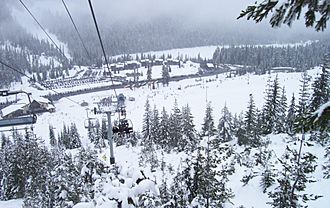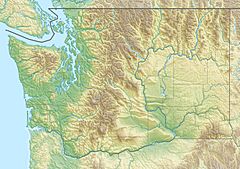White Pass Ski Area facts for kids
Quick facts for kids White Pass Ski Area |
|
|---|---|

Looking northward, down the liftline
|
|
| Location | White Pass, Washington |
| Nearest city | Yakima - 53 mi (90 km) Morton - 54 mi (90 km) |
| Coordinates | 46°38′07″N 121°23′15″W / 46.63528°N 121.38750°W |
| Vertical | 2,000 ft (610 m) |
| Top elevation | 6,500 ft (1,980 m) |
| Base elevation | 4,500 ft (1,370 m) |
| Skiable area | 1,402 acres (5.7 km2) |
| Runs | 45 |
| Lift system | 6 chairlifts, - 2 hi-speed quads - 1 quad - 1 triple - 2 doubles 2 surface lifts - 1 platter lift - 1 magic carpet |
| Lift capacity | 9,700 / hr |
| Snowfall | 350 in (890 cm) |
| Snowmaking | At base area on Far East and Poma Face |
| Night skiing | limited: Saturdays & holidays |
| Website | Ski White Pass.com |
The White Pass Ski Area is a fun place to ski and snowboard in the Pacific Northwest region of the United States. It's located in the Cascade Range at White Pass, Washington. You can find it about 53 miles (90 km) west of Yakima and 54 miles (90 km) east of Morton on US-12. It's also pretty close to some big mountains, about 25 miles (40 km) southeast of Mount Rainier and 30 miles (50 km) north of Mount Adams.
Contents
Alpine Skiing Adventures
Alpine skiing is what most people think of when they imagine skiing down a mountain. At White Pass, the bottom of the ski area is 4,500 feet (1,370 m) above sea level. The highest point you can reach by lift is 6,500 feet (1,980 m). This means you get to ski down a total of 2,000 feet (610 m)! The slopes mostly face north, which helps keep the snow in good condition.
The mountain has six different chairlifts to take you up:
- Two fast high-speed quad lifts (these chairs detach from the cable at the top and bottom to slow down, making it easier to get on and off).
- One regular quad lift.
- One triple lift.
- Two double lifts.
There are also two surface lifts, which pull you along the snow:
- A platter lift (like a disc you hold between your legs).
- A magic carpet (a moving conveyor belt) for beginners.
If you love tricks and jumps, White Pass has a terrain park. It often hosts cool events like "rail jams" and "slopestyle" competitions. You can find it on a run called Rib Eye, near the Basin Quad lift.
Exploring Cross-Country Skiing
If you prefer a different kind of skiing, the Nordic Center at White Pass is perfect for cross-country skiing. It gives you access to 18 km (11 mi) of trails in the Wenatchee and Gifford Pinchot National Forests. These trails are groomed, meaning they are specially prepared for skiing.
You can try classic cross-country skiing, which uses a gliding motion, or skating cross-country, which is faster and more like ice skating. You can also go snowshoeing here. The trails offer different challenges, so there's something for everyone, no matter your skill level.
What's at the Base?
The main building at the bottom of the ski area is called the day lodge. Here, you can rent skis and snowboards if you don't have your own. There's also food available to refuel after skiing, and lockers to keep your belongings safe.
If you want to stay overnight, the White Pass Village Inn is right across the highway. It offers cozy places to sleep so you can be ready for another day on the slopes.
A Look at White Pass History
White Pass Ski Area first opened its doors in January 1953. Back then, it was much smaller, with just the Poma Face hill and a few Rope tows to pull skiers up.
Soon after, they built a Poma surface lift. This lift ran from where the lodge is now to the top of the Poma Face.
In 1956, White Pass grew bigger! They added their very first chairlift to the top of Pigtail Peak. This two-person lift was called Pigtail I. It was about a mile long and took skiers up 1,500 feet (460 m) to an elevation of 6,000 feet (1,830 m). The resort then cut two long runs from the top, naming them Holiday and Cascade.
Another double chairlift, Pigtail II, was added in the fall of 1958. It ran next to the first Pigtail lift and could carry even more skiers. This new lift cost over $200,000! They also made the Cascade run wider and added two new runs from the summit: Mach V and Paradise. For the 1958–59 season, White Pass started being open all week, and a daily lift ticket for an adult cost $3.50.
In 1964, a new double chairlift called Chair 3 was added for the beginner area. It started near the highway and went to a flat area below Cascade Cliff.
Did you know that famous World Cup racing twins Phil and Steve Mahre grew up at White Pass? Their father, Dave "Spike" Mahre, was the mountain manager. The twins and their seven brothers and sisters lived in a house right near the ski lifts!
In 1984, Chair 4, another double lift, was installed. This lift ran from halfway down Paradise to the top of Pigtail Peak. Three new runs were also created around Paradise that ended at this new lift.
To help more people get up the mountain faster, White Pass installed a high-speed detachable lift in 1994. This lift, called the Great White Express, could carry almost twice as many people as the two Pigtail lifts combined! The old Poma surface lift and Pigtail I were removed to make space for the Great White.
In 2000, the beginner area got a big update. The last rope tow was replaced with a platterpull lift. Chair 3 was removed, and a new triple lift called Far East was installed. This new lift started in a newly cleared area and went to the top of the Poma Face.
A big expansion happened in the Paradise Basin for the 2010–11 season. This added 767 acres (3.1 km2) of new skiing terrain and two more new chairlifts. The Basin Quad is a regular quad lift, and the Couloir Express is the second high-speed detachable quad at White Pass. A new lodge was also built between these new chairlifts.
It's interesting to know that Pigtail II is one of the oldest chairlifts still running in North America! As of 2019, it's the second-oldest operating chairlift in Washington state.
Trail Map Information
With all the new terrain, White Pass needed a new trail map to show where everything was. The famous map artist James Niehues drew the new map. The resort even let skiers help decide the names of the new runs using Facebook!



